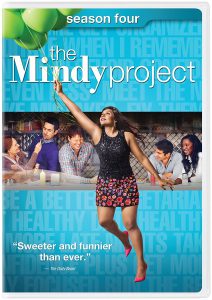Sitcoms aren’t usually the best genre to binge-watch, as they tend to not have the dramatic stakes or surprises that make you want to jump right into the next episode. Often, sitcoms work well as something to have on in the background. But “The Mindy Project” — of which I binged Seasons 4 and the first part of Season 5 before my free month of Hulu ran out – is an exception.
The stakes mostly remain at sitcom level (the sequence where Mindy and Danny break up required some tears, but it’s handled with a deft and brisk touch). And it certainly has some mid-run tropes, such as Mindy Lahiri (Mindy Kaling) and Danny Castellano’s (Chris Messina) baby Leo. The introduction of the baby doesn’t mark the downfall of the show, however; it leads to more good premises, such as Mindy taking him to a soap-opera audition and blowing it. The workplace – in this case, an ob/gyn practice where Mindy is among the top doctors — is comfortingly familiar, but that doesn’t set it apart from other sitcoms.
What makes “The Mindy Project” a bit different is that 1) all the characters are hilariously (but mostly innocently) flawed, 2) they don’t dwell on their flaws, largely because they are unaware of them (or have suppressed their awareness), and 3) the show remarks on these flaws through non sequiturs, 95 percent of which land, and half of which are guffaw-worthy. Yes, “Mindy” is a formulaic workplace sitcom, but it’s not pleasant background noise — it is best enjoyed by those who watch it closely.
For example, Jody (“Terminator: The Sarah Connor Chronicles’ “ Garret Dillahunt) is asked if he’s the one who eats out of the garbage. “No, that’s Morgan … and Beverly … and Mindy,” he replies, increasingly disturbed as he reflects on his coworkers’ habits. The line is especially funny because those three have been established as the types who would eat out of the garbage.
In the pilot episode in 2012, Mindy makes a drunken speech at an ex’s wedding, then rides a bicycle into a swimming pool and gets arrested. That’s amusing, but her antics since then have been funnier, because we mostly know about them from the non sequiturs. It all adds up to an absurdly pathetic life if one were to take it point-by-point. Her prom date was her mom dressed up as her cousin, she once burned her butt cheeks on her heated toilet seat, and the most she ever ran was when her jacket got caught in a bus door for four blocks.
The supporting cast is certainly not immune to embarrassments. Collette (“Chelsea Lately’s” Fortune Feimster) was on “SportsCenter” when she fell out of the second deck at a Braves game, Morgan (Ike Barinholtz, whose physical comedy prowess makes him the show’s best secret weapon) ate lasagna for the first time in his 30s, and Jody has been shot in duels so many times that his shoulder is more lead than bone.

“Mindy Project” has put a lie to the dictum that it’s always better to “show, not tell.” Here, the opposite is the case, because our imaginations can do the work. And we can also quickly move on to the next random line, such as Mindy describing her figure as “slight” or someone making a penis reference — without a doubt, “Mindy” has the highest ratio of penis mentions per episode; easily above 1.0, although I haven’t done the precise calculation.
The non sequiturs work because the characters have been so well-defined when we do see them in action. Part of what makes them likable is that they cover the diversity spectrum, yet they don’t clash over race, gender, sexual orientation, religion, economic class, age or political views. (The office includes an Indian-American, a devout Catholic, an African-American, a lesbian, a Brit, a sexagenarian, an old-fashioned Southern gentleman … and Morgan.) Those topics regularly come up in throwaway lines – it’s canonical that Mindy sees Boston as being more racist than the South, and that she finds Bill O’Reilly strikingly handsome – without the show ever doing a “statement” episode.
Jody is absurdly rich (he owns an entire floor of a building) while Morgan and Beverly are shockingly poor (it’s been suggested that the latter lives in an alley). Danny could bike to the Manhattan office from his brownstone, Ben (Bryan Greenberg) commutes by train from the New Jersey suburbs. Tamra (Xosha Roquemore) is a fashion plate, Morgan buys his clothes from street vendors. Although they come from (and live in) different walks of life, their lives are all imperfect.
While they are all Hollywood good-looking, we don’t feel like they are better than us. Mindy is never lacking for a handsome guy to date, but I feel like that Seinfeldian cliché is a wink at the audience, too. (While Kaling isn’t shaped like a supermodel, her confidence and wit makes her pretty much the sexiest woman on TV as far as I’m concerned. I also admire the fact that just about any guy – except Morgan, natch – falls into Mindy’s wheelhouse, including past dates played by Ed Helms and and Seth Rogen.)
The writing team – which includes Kaling and Barinholtz – has maintained its consistent voice through a high number of cast shifts. Sweet and shy receptionist Betsy (Zoe Jarman) was my favorite original character; she’s long gone, but part of why the show doesn’t suffer for long is that most of the newcomers have slid right in. (I thought Adam Pally’s Peter – essentially reprising his “Happy Endings” role – was a bit out of place, but Peter has since moved to Texas.) While some fans lamented the decreased role of Danny and the increased role of Jody, Dillahunt – who uses a deadpan expression to different effect than in “Terminator” — is my favorite new addition of the Hulu era.
In the same way “Seinfeld” pioneered minutiae humor and “The Office” broke new ground with the awkward pause, “The Mindy Project” has turned the non sequitur into high art. The characters’ actions are often stupid, but the writing is among the smartest on TV – in an era when formulaic sitcoms have largely been supplanted by bingable serials.

